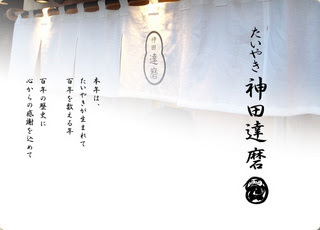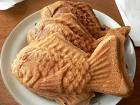[ . BACK to DARUMA MUSEUM TOP . ]
. tabi 足袋 と伝説 Legends about Tabi socks .
:::::::::::::::::::::::::::::::::::::::::::::::::::::::::::::::::::::::::::::::::::::::::::::::::::::
Socks and toe socks
These socks come in various traditional patterns and have the split toe for use with Geta clogs and Zori Sandals
 . . . CLICK here for TABI Photos !
. . . CLICK here for TABI Photos !
.......................................................................
tabi 単皮 (たび)were originally made of deer skin, the use of the Chinese characters 足袋 came later.
- another explanation
tabi 多鼻 "many noses", because the big toes stuck out like that.
The fore-runner of Tabi, the 下沓 / 襪
Shitauzu, were used by the aristocracy and soon made of silk, to keep the feet warm in winter.
Tabi (足袋)
are traditional Japanese socks. Ankle high and with a separation between the big toe and other toes, they are worn by both men and women with zori, geta, and other traditional thonged footwear. Tabi are also essential with traditional clothing—kimono and other wafuku. The most common colour is white, and white tabi are worn in formal situations such as at tea ceremonies.
Jika-tabi 地下足袋 Antique Japanese (samurai) armoured tabi
Construction workers, farmers and gardeners, rickshaw-pullers, and other workmen often wear a type of tabi called jika-tabi (地下足袋 tabi that contact the ground). Made of heavier, tougher material and often having rubber soles, jika-tabi resemble boots and are outer footwear rather than socks. Like other tabi, jika-tabi are toe-divided so they can be worn with slip-on thonged footwear. Shōjirō Ishibashi, the founder of major tire company Bridgestone Corporation, is credited with their innovation.
Though slowly being replaced by steel-toed rigid-sole construction shoes in some industries, many workers prefer them for the softness of their soles. This gives wearers tactile contact with the ground and lets them use their feet more agilely than rigid-soled shoes allow: for instance, people who traverse girders on construction sites like to know what is under their feet, and craft practitioners such as carpenters and gardeners additionally use their feet as if they were an extra pair of hands, for example to hold objects in place.
© More in the WIKIPEDIA !
- quote -
Traditional Japanese Footwear
- snip -
..... With all this footwear, one wears tabi socks, designed to be worn with thong toes, unless wearing a casual, cotton yukata kimono, in which case one does not wear tabi. Another exception is the waraji sandals, often worn without tabi, especially by workers in rural areas. The older style of tabi is non-stretch, with kohaze fasteners, and the more contemporary style is stretchy and without fasteners. Shoes are removed when entering a Japanese home; one walks on their scrupulously clean floors in one’s tabi socks or a pair of indoor tatami sandals. You can see tabi being worn in the photo at the very top of this footwear blog post, with the black zori.

You can also get knee high, stirrup stockings, a sort of leggins, called
脚絆 / 脚半
kyahan, to wear under tabi.
There is also other tabi toed footwear, such as
jika-tabi, worn as outdoor tabi like ninja boots, worn in some martial arts or just worn casually. They are a 20th century creation. The example below is a pair of canvas, rubber soled tabi boots, with kohaze fasteners. Nike also recently produced a range of tabi toed trainer shoes and boots, called
Nike Rifts, to introduce the acupressure effects of tabi toes to the sports trainer. .....
- source : wafuku.wordpress.com/2009 -
.................................................................................
Daruma Tabi Socks in three colors

.................................................................................
Daruma Tabi 達磨足袋

:::::::::::::::::::::::::::::::::::::::::::::::::::::::::::::::::::::::::::::::::::::::::::::::::::::
Socks with five toes 五本指 ソックス
gohonyubi sokkusu
gohon-yubi no kutsushita 5本指の靴下
 . . . CLICK here for Photos !
Toe socks
. . . CLICK here for Photos !
Toe socks
are socks that have been knitted so that each toe is individually encased the same way that fingers are individually encased in a glove.
All sock lengths are available as toe socks, from anklet and ankle socks through to knee-high and over-knee socks. They are also available with rubber soles.
Toe socks came into popularity in the 1970s and made a comeback in the 1990s as a novelty item worn by adolescents. These later socks are usually almost knee high, striped, and sometimes worn with flip-flops to make a fashion statement.
© More in the WIKIPEDIA !
:::::::::::::::::::::::::::::::::::::::::::::::::::::::::::::::::::::::::::::::::::::::::::::::::::::
Tabi toe boots
a kind of black shoe for workers, now fashionable with the young ones.
Some have quite a fancy design, click on the thumbnail below.

The inside of the tabi called
Kin Kakuji (golden temple) boots have been lined with Japanese fabric showing off the Honmonoya red label and featuring daruma.
Daruma are Japanese wishing dolls.

These tabi are made for dancing or funky street strolling!
www.tokyomade.com/blog/2008/11/
:::::::::::::::::::::::::::::::::::::::::::::::::::::::::::::::::::::::::::::::::::::::::::::::::::
H A I K U
kigo for all winter
tabi 足袋 (たび) Tabi socks
shirotabi 白足袋(しろたび)white tabi socks
kontabi 紺足袋(こんたび)blue tabi socks
irotabi 色足袋(いろたび)colored tabi socks
tabi arau 足袋洗う(たびあらう)to wash the tabi socks
tabi hosu 足袋干す(たびほす)to dry the tabi socks
. WKD : Warm Things in Winter
:::::::::::::::::::::::::::::::::::::::::::::::::::::::::::::::::::::::::::::::::::::::::::::::::::::
kigo for all summer
natsu tabi 夏足袋 (なつたび) Tabi for summer
..... hitoetabi, hitoe-tabi 単足袋(ひとえたび)
Tabi for
hitoe-summer robes
.SAIJIKI ... HUMANITY - Kigo for Summer
:::::::::::::::::::::::::::::::::::::::::::::::::::::::::::::::::::::::::::::::::::::::::::::::::::::
. Yosa Buson 与謝蕪村 (1715-1783) .
足袋はいて寝る夜物うき夢見哉
tabi haite neru yo monouki yumemi kana
Split-toe socks on,
I slept at night,
Dreaming a weary dream.
Tabi (足袋) is heavy-soled socks made with a split in the toe section between the big toe and second toe. (大英和)
According to Prof. Ogata, in Japan there used to be a saying,
"Go to bed with split-toe socks on,
and you won't be able to attend your parents' deathbed".
Now the saying may be said to be rather a superstition.
- - Impression:
Though he knew well what the old saying meant, the night was so cold that he could not help wearing split-toe socks in the bed. That night he did not sleep well, as the dream was very weary. He wonders whether, as the superstitious old saying goes, the tabi did disturb his usual sound sleep.
The Poet wrote the Haiku at the age of 53, 1768. Considering his age at death 68, 1783, the Poet was not so aged when he composed the Haiku. Mr. Takahashi comments that the Haiku expresses the lonely sleep of an elderly man leading a wretched life.
It can be safely accepted that the man in the Haiku is the Poet himself. His prolific periods started when he was 51, 1766. Two years later, at the age of 53, he must have been active and energetic in daily lives. I hardly agree to Mr. Takahashi's comment in this respect. It will be better to suppose that it was a terribly record cold night. Bare-foot in bed, he couldn't easily get to sleep and with split-toe socks on he happened to have a bad dream. He regretted a little that it was anything but a deep sleep. I think that his way of putting it comes close to expressing actual feelings of commoners as to how they spend a severely cold night.
- source : hokuoto77.com/buson-wi -
Wearing tabi socks
asleep in the melancholic night —
dreaming.
Tr. Allan Persinger
:::::::::::::::::::::::::::::::::::::::::::::::::::::::::::::::::::::::::::::::::::::::::::::::::::::
 男らの汚れるまへの祭足袋
男らの汚れるまへの祭足袋
otokora no yogoreru mae no matsuri tabi
these men's
festival tabi
before they get dirty
Iijima Haruko 飯島晴子 (1921 - 2000)
:::::::::::::::::::::::::::::::::::::::::::::::::::::::::::::::::::::::::::::::::::::::::::::::::::::
浮世絵 Ukiyo-E motives on Tabi
 CLICK for more photos !
. Edo shokunin 江戸職人 craftsmen, artisan, Handwerker .
CLICK for more photos !
. Edo shokunin 江戸職人 craftsmen, artisan, Handwerker .
The making of Tabi from cotton began in the Edo period after 1655. Before that they were made from leather and made by specialists 切皮屋 kirikawaya. They were quite expensive, but with the growth of the city population, the need for cheaper footwear became necessary. As cotton was grown more and more, the price for Tabi became reasonable.
They were made in white for women and black for men and they were not take off when entering a home.
tabiya 足袋屋 making tabi socks
source : edoichiba tabi
tabi shokunin 足袋職人 craftsman making Tabi socks
. Edo no shokunin 江戸の職人 Edo craftsmen .
Tabi are made of three pieces, the sole, the inpiece (inners) (usually white) and the outer piece (uppers), which soon became a popular fashion item in Edo. But the Tabi makers also sold other items, expecially men's underwear.
Since Tabi were only worn in the winter time, the Tabiya was a seasonal worker.
Poor folks in Edo did not use Tabi in any season, and the cheap prostitutes were not allowed to wear them at all. There are some Ukiyo-E paintings with barefeet girls in winter, eating soba 蕎麦 hot buckwheat soup by the roadside to keep warm.
 source : s.webry.info/sp/rakugo-fan.at.webry.info
Shop sign of a Tabi store 足袋店看板 :
source : s.webry.info/sp/rakugo-fan.at.webry.info
Shop sign of a Tabi store 足袋店看板 :
momohiki 股引 "men's underwear"
Tabi were made to order, so the Tabi maker first took measurements of the client's foot. Then he worked on a paper model. The various parts were then cut out with a special knife and sown together by hand. The toes parts were then stripped over a wooden board and hit with a mallet to make them soft.
The size of a Tabi is counted in MON 文, since it was measured by placing many MON coins side by side until the size was covered.

The ruler of a Tabi maker was called
monshaku 文尺
- quote -
Bringing Japanese Tabi to the World
Each pair of pop tabi is carefully handmade by artisans. As there are many stages in the production process, it takes a long time to make a pair of tabi. Small pieces are stitched together to produce a durable and smooth tabi. Once the foot has been firmly placed inside a tabi, it is fastened with metal clasps called 小鉤 / 鞐/ 小鈎 “
kohaze.”

About 80% of tabi in Japan used to be manufactured in 行田市
Gyoda City、Saitama. The footwear business for travelers flourished because of Gyoda City’s proximity to Nakasendo, one of the five highways of the Edo period and also because
cotton – one of the main materials used to make tabi – was produced there.
At its peak,
there were almost 300 tabi makers there. But because the custom of wearing tabi was lost with the changing times, the number of tabi makers decreased so that these days there are only 11 remaining.
- source : deepjapan.org -
:::::::::::::::::::::::::::::::::::::::::::::::::::::::::::::::::::::::::::::::::::::::::::::::::::::
. Legends and Tales from Japan 伝説 - Introduction .
. tabi 足袋 と伝説 Legends about Tabi socks .
:::::::::::::::::::::::::::::::::::::::::::::::::::::::::::::::::::::::::::::::::::::::::::::::::::::
[ . BACK to WORLDKIGO TOP . ]
[ . BACK to DARUMA MUSEUM TOP . ]
:::::::::::::::::::::::::::::::::::::::::::::::::::::::::::::::::::::::::::::::::::::::::::::::::::::



























































